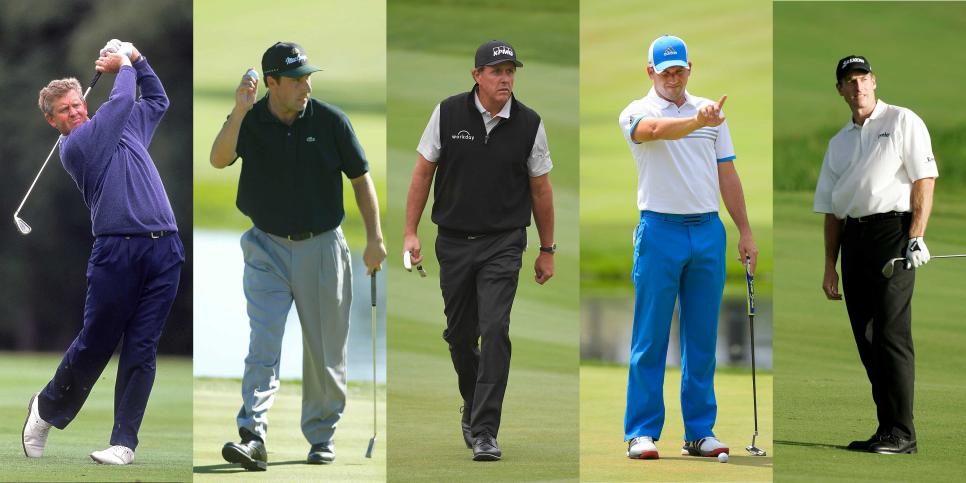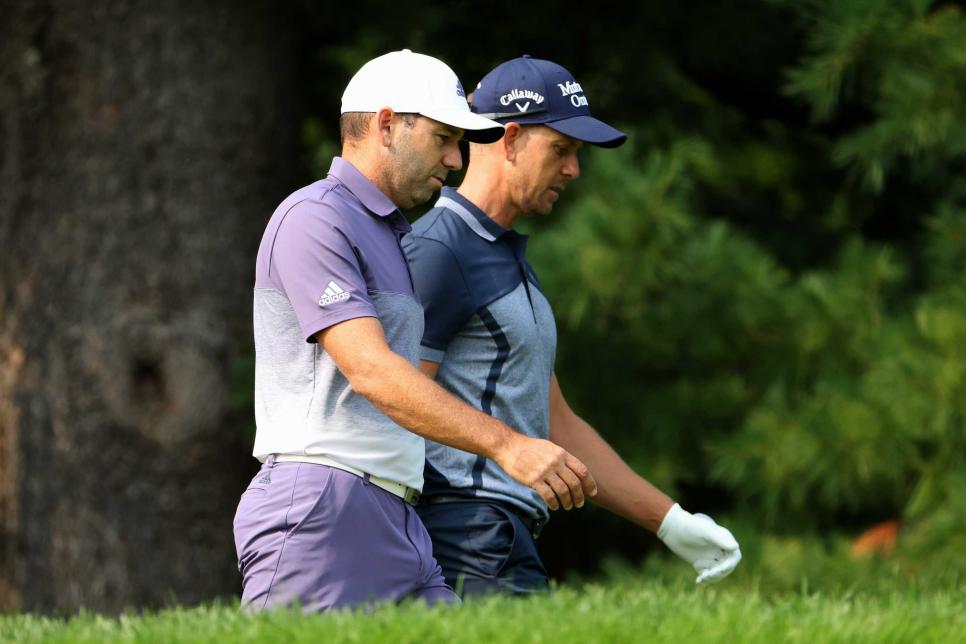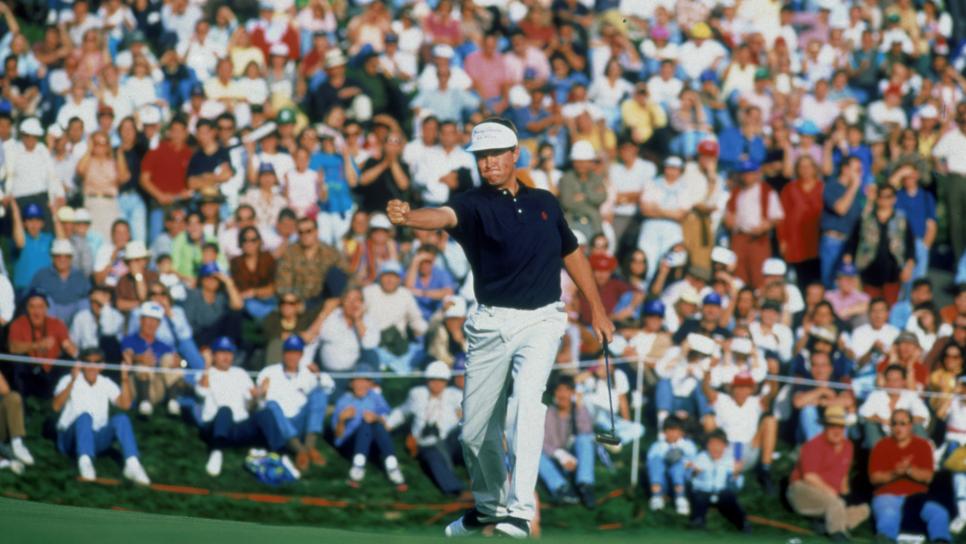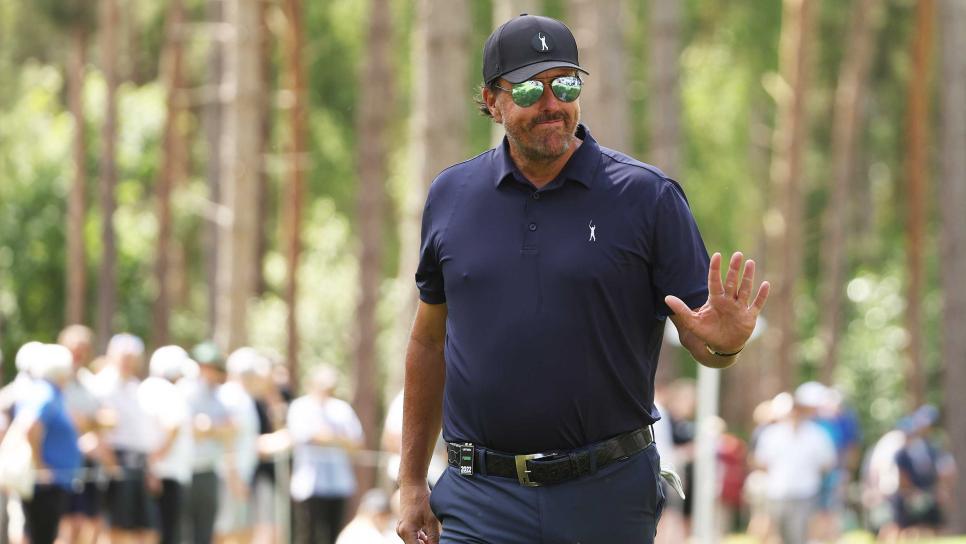Ranking
The 12 most surprising players who never reached No. 1 in the OWGR

When the Official World Golf Rankings first came out on April 6, 1986, Germany's Bernhard Langer was the first to hold the title of World No. 1. It turns out he nabbed that honor in the nick of time. Within three weeks, Seve Ballesteros overtook him, and Langer did not make it back to the top spot again. If the system had come out that May rather than April, Langer would never have been able to join the 25 men who carry the distinction of being able to call themselves "former World No. 1" (see bottom of the article). Indeed, he’s one of the lucky ones—others have not been so fortunate.
The list of players that follows are that group, those who never made World No. 1 but, at the very least, seem like they should have. This excludes players like Jack Nicklaus or Arnold Palmer whose primes came much earlier than the OWGR era. The World Ranking has been awash in controversy lately as LIV Golf seeks to secure rankings points for its players. But the players below were not excluded or banned—they simply never quite made that last ascent up the long mountain top and have never officially been considered the very best golfer in the world.
Honorable Mention: Tom Watson
OK, we get it—Watson's prime was a little earlier. But unlike Nicklaus, who seems to belong in spirit to an earlier generation, Watson still feels relevant in the mid-to-late 1980s. This is a guy who was winning PGA Tour events until 1998 and captured five majors in three years not long before the OWGR began. Between 1979 and 1983, he was absolutely the best player in the world, but somehow he never even cracked the top 10 in the OWGR era. When you look at the results, it's not that strange, but somehow it doesn't feel right. Hence, an honorable mention.
T-10: Sergio Garcia and Henrik Stenson

Jamie Squire
You'll have to allow us one tie here, because their stories follow the same lines. Sergio is 42, Stenson is 46. Sergio won a major, spent 453 weeks in the top 10, and was No. 2 in the world for 18 weeks. Stenson won a major, spent 338 weeks in the top 10, and had 24 weeks at No. 2. Both were close … but both also existed in the Tiger Woods/Phil Mickelson era, and if you weren't at all familiar with the OWGR and someone asked you if either had been ranked No. 1, you'd probably say no. They easily could have been top dogs in the world, but it doesn't exactly blow your mind that they didn't get there.
9: Steve Stricker
Would you believe that Stricker spent 12 weeks as the No. 2 player in the world, and 254 weeks in the top 10? Sure, he had his slumps, but his 2009-2011 seasons were scintillating, and came on the heels of Tiger's 2009 Thanksgiving "mishap." In that span, he won seven tournaments, including a playoff event. The truth is, though, that even in Stricker’s weeks at No. 2, Tiger Woods was comfortably ahead. You're going to hear this a lot on this list: In a world without Tiger, Stricker would have been there. In real life, he probably needed at least two majors to have a prayer of catching up, and the surprise with Stricker is that in that same 2009-2011 period, he only produced one top-10 in the majors.
8: Davis Love III

David Cannon
Here we start to get into the guys who are actually more surprising. Love had 24 OWGR wins in his career, spent five weeks at No. 2 and has an astounding 466 weeks in the top 10. In fact, in 1992, he won three tournaments in four weeks, starting with the Players Championship … and went from 12th in the world to eighth. The OWGR was far less responsive to recent form then, and clearly it hurt Love. By the time he reached No. 2 in 1998, we were firmly in the Tiger Woods era, but Love actually came close—he was just a point behind Woods for a month that year.
7: Mark O'Meara
This one's easy—there are two men in the OWGR era who have won two majors in the same calendar year and still failed to reach the No. 1 mark. O'Meara is one, and the other's coming later. The crowning achievement of O’Meara’s career came in 1998, when he won both the Masters and the Open Championship. Late that year, he got to within 1.5 points of the World No. 1, and you will absolutely, positively, never in your life guess who stood in his way. Never. Don't even try.
6: Collin Morikawa
Admittedly, this is a weird one. Morikawa is 25 years old and has all the time in the orld to reach No. 1. I would bet a large sum that he will get there before he's 30. Still—still!—it's a little bit wild that he hasn't done it already. He's already spent 24 weeks at No. 2, which is more than all but three people in the history of the rankings, and he's come into plenty of tournaments already in the "win and you're No. 1" position. It's reminiscent of Justin Thomas before him, who had some similar close calls before he broke through. Unlike some of the others on this list, Morikawa didn't have the Tiger juggernaut to overcome—he was as close as 0.3 points to Jon Rahm as recently as March. Then Scottie Scheffler turned into a human meteor, and Morikawa was forced to wait his turn.
5: Jim Furyk

Getty Images
Furyk holds the honor of having been in second place for the second-most weeks of the players on our list—a consummate runner-up. He was the bridesmaid for 39 weeks total, and part of the problem, of course, is that by the time he won his one major at the 2003 U.S. Open, he was deep in the heart of Tiger dominance—and also not at his own OWGR peak. Furyk's consistency across his career has been wildly impressive, as well as his win total (20 counting for OWGR), but a solid career with PGA Tour wins and a solitary major just doesn't get it done when Tiger is walking the same courses. Furyk broke into the top 10 in 2000, when Woods was having arguably the greatest year in golf history, and climbed to No. 2 in 2006, the year he won the Vardon Trophy for low scoring average while Woods won every other award. When he won the Canadian Open to get to No. 2 for the first time, by a slim margin over Mickelson, Fuyrk’s points average was 8.90. Tiger’s was 22.8. As you might imagine, that race never tightened up. Furyk stuck around the top three through 2007 and made a run back into the top five in 2010, but there was just no room to dream of No. 1 in Tiger's shadow.
4: Padraig Harrington
How do you win three majors in two years and never even get to No. 2 on the OWGR? It's baffling, and if you had asked me before compiling this list if he ever hit No. 1, unlike many others I would have said yes, surely he had it for at least a week in 2008. But no—the 2008 Open Championship rocketed him from 13th to third, but winning the PGA Championship a few weeks later did absolutely nothing for him. Again, I'd be extremely curious to see how the modern system would be different, and I think he would have benefited far more, but in that late summer of 2008, he couldn't even get within two points of Mickelson. And Tiger? Well, Tiger …
3: Jose Maria Olazabal
Olazabal is third all-time in weeks spent at No. 2—35 total—and had 29 OWGR wins to his name. Like Love, Olazabal was hurt by a more static World Ranking system, and looking back, you can see some baffling trends, like the time he won the Masters as the No. 10 player in the world, and only rose to No. 7, and then rose just one more spot when he won again a few weeks later. For almost all of 1991, he was just behind No. 1 Nick Faldo and, then, Ian Woosnam, often achingly close. And when Olazabal finally overcame them in early '92, it happened to be at the exact moment when Fred Couples briefly became a god, winning three tournaments in six weeks, with the last at the Masters. I mean, look how close he got:
If you're looking for an OWGR tragic figure, Olazabal is your guy. (Well, until we get to No. 1.)
2: Colin Montgomerie
Monty actually had fewer weeks at No. 2—just 24, a total Morikawa has already equaled—but more than 400 weeks in the top 10. And despite the fact that he never won a major, he was otherwise a winning machine; he captured 37 OWGR wins, which is second most of anyone who never reached the top spot. Considering that he hit his prime in 1996, just before Tiger, it's a stumper that he never made it. The culprit in his case was Greg Norman, whose mid-1990s resurgence included a bunch of wins on various tours and seven major top-10s in two years. The margin was inside one point for a period in the middle of 1996, but Monty couldn't get any closer. A year later, Tiger was on the scene, Monty hit his mid-30s, and though he had plenty of very good golf left on the European Tour, that was the end of his chance to seize the top spot. Like others on this list, he needed a major at the right time and just couldn't ever get it.
1: Phil Mickelson

Matthew Lewis
This is my favorite stat from the entire OWGR universe: Jim Furyk has spent 39 weeks at No. 2, which is second all-time. Phil Mickelson is first on that list. His total weeks at No. 2? 270. Two hundred and seventy! That's more than five cumulative years! He first reached No. 2 in 2001 when he won the Buick Invitational, and clearly, he sat in that spot for years and years and years. What else can you say? This is what happens when a generational talent like Phil has the misfortune of hitting his prime after the emergence of the greatest winner in the history of individual sports. All that said, Phil had his chance, and it came late in the day, in the months following his 2010 Masters win. He came within a point of Tiger that May, and nearly got within a half point by late June. Finally, by August, he was just a half point away, and by the end of the month the margin was less than 0.3. This, of course, was one of Woods' worst seasons, when he didn't win a single event, changed swing coaches, and was still recovering from the Thanksgiving 2009 debacle. By late October, Woods was ready to fall out of the No. 1 spot. And here's what happened when he did:
Certain things just aren't meant to be.
Players who have been World No. 1
Tiger Woods (683), Greg Norman (331), Dustin Johnson (135), Rory McIlroy (106), Nick Faldo (97), Seve Ballesteros (61), Luke Donald (56), Jason Day (51), Ian Woosnam (50), Brooks Koepka (47), Nick Price (44), Jon Rahm (43), Vijay Singh (32), Scottie Scheffler (29*), Jordan Spieth (26), Lee Westwood (22), Fred Couples (16), David Duval (15), Justin Rose (13), Adam Scott (11), Ernie Els (9), Martin Kaymer (8), Justin Thomas (5), Bernhard Langer (3), Tom Lehman (1)
*Current World No. 1

